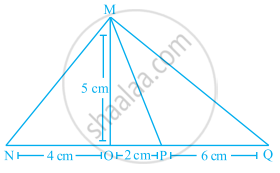Advertisements
Advertisements
प्रश्न
If `a≠ b ≠ c`, prove that the points (a, a2), (b, b2), (c, c2) can never be collinear.
उत्तर
GIVEN: If `a≠ b≠ c`
TO PROVE: that the points (a,a2), (b,b2) ,(c,c2),can never be collinear.
PROOF:
We know three points (x1,y1),(x2y2),and (x3,y3) are collinear when
`1/2[[x_1(y_2-y_3)+x_2(y_3-y_1)+x_3(y_1-y_2)]=0`
Now taking three point (a,a2),(b,b2),(c,c2),
Area `=1/2[a(b^2-c^2)+b(c^2-a^2)+c(a^2-b^2)`
`=1/2[ab^2-ac^2+bc^2+ba^2+ca^2+cb^2]`
`=1/2[(a^2c-a^2b)+(ab2-ac^2)+(bc2-b^2c)]`
`=1/2[-a^2(b-c))+(a(b^2-c^2))-(bc(b-c))]`
`=1/2(b-c)(-a^2)+(a(b+c))-bc]`
`=1/2(b-c)(-a^2)+ab+ac-bc]`
`=1/2(b-c)(-a)(a-b)+c(a-b)]`
`=1/2(b-c)(a-b)(c-a)`
Also it is given that
a≠ b≠ c
Hence area of triangle made by these points is never zero. Hence given points are never collinear.
APPEARS IN
संबंधित प्रश्न
Find the area of the triangle whose vertices are: (2, 3), (-1, 0), (2, -4)
Determine the ratio in which the line 2x + y – 4 = 0 divides the line segment joining the points A(2, – 2) and B(3, 7).
Find the area of the following triangle:

Find the area of the quadrilaterals, the coordinates of whose vertices are
(1, 2), (6, 2), (5, 3) and (3, 4)
The four vertices of a quadrilateral are (1, 2), (−5, 6), (7, −4) and (k, −2) taken in order. If the area of the quadrilateral is zero, find the value of k.
Prove that the points (2,3), (-4, -6) and (1, 3/2) do not form a triangle.
In a ΔABC, AB = 15 cm, BC = 13 cm and AC = 14 cm. Find the area of ΔABC and hence its altitude on AC ?
If the area of triangle ABC formed by A(x, y), B(1, 2) and C(2, 1) is 6 square units, then prove that x + y = 15 ?

In Figure 1, PS = 3 cm, QS = 4 cm, ∠PRQ = θ, ∠PSQ = 90°, PQ ⊥ RQ and RQ = 9 cm. Evaluate tan θ.
Ratio of areas of ∆MNO, ∆MOP and ∆MPQ in the given figure is ______.

